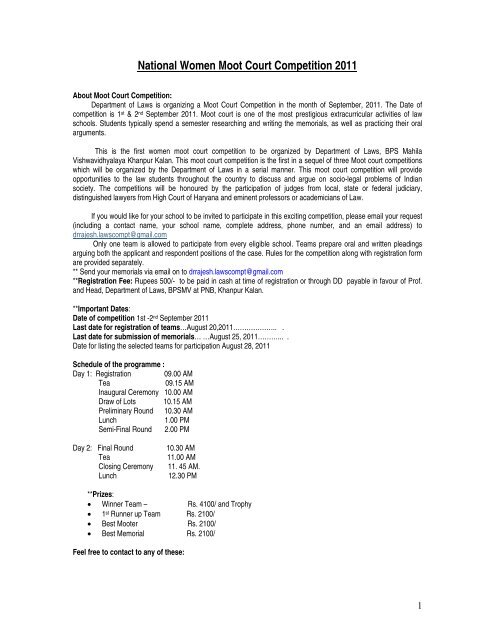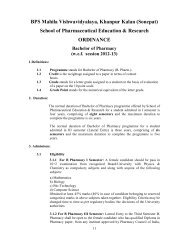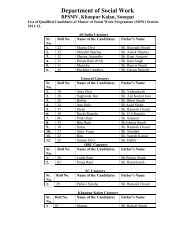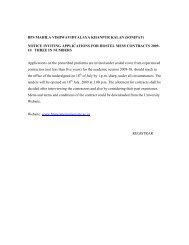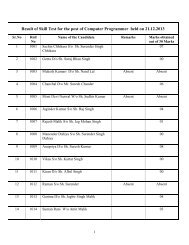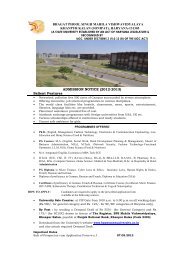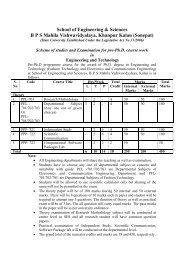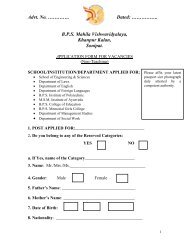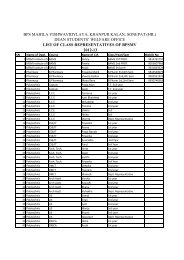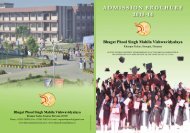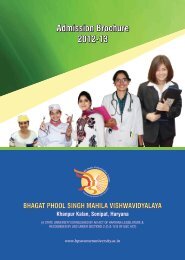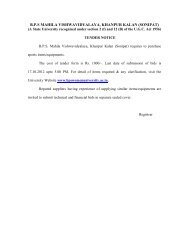National Women Moot Court Competition 2011
National Women Moot Court Competition 2011
National Women Moot Court Competition 2011
Create successful ePaper yourself
Turn your PDF publications into a flip-book with our unique Google optimized e-Paper software.
<strong>National</strong> <strong>Women</strong> <strong>Moot</strong> <strong>Court</strong> <strong>Competition</strong> <strong>2011</strong>About <strong>Moot</strong> <strong>Court</strong> <strong>Competition</strong>:Department of Laws is organizing a <strong>Moot</strong> <strong>Court</strong> <strong>Competition</strong> in the month of September, <strong>2011</strong>. The Date ofcompetition is 1 st & 2 nd September <strong>2011</strong>. <strong>Moot</strong> court is one of the most prestigious extracurricular activities of lawschools. Students typically spend a semester researching and writing the memorials, as well as practicing their oralarguments.This is the first women moot court competition to be organized by Department of Laws, BPS MahilaVishwavidhyalaya Khanpur Kalan. This moot court competition is the first in a sequel of three <strong>Moot</strong> court competitionswhich will be organized by the Department of Laws in a serial manner. This moot court competition will provideopportunities to the law students throughout the country to discuss and argue on socio-legal problems of Indiansociety. The competitions will be honoured by the participation of judges from local, state or federal judiciary,distinguished lawyers from High <strong>Court</strong> of Haryana and eminent professors or academicians of Law.If you would like for your school to be invited to participate in this exciting competition, please email your request(including a contact name, your school name, complete address, phone number, and an email address) todrrajesh.lawscompt@gmail.comOnly one team is allowed to participate from every eligible school. Teams prepare oral and written pleadingsarguing both the applicant and respondent positions of the case. Rules for the competition along with registration formare provided separately.** Send your memorials via email on to drrajesh.lawscompt@gmail.com**Registration Fee: Rupees 500/- to be paid in cash at time of registration or through DD payable in favour of Prof.and Head, Department of Laws, BPSMV at PNB, Khanpur Kalan.**Important Dates:Date of competition 1st -2 nd September <strong>2011</strong>Last date for registration of teams…August 20,<strong>2011</strong>……………….. .Last date for submission of memorials… …August 25, <strong>2011</strong>………... .Date for listing the selected teams for participation August 28, <strong>2011</strong>Schedule of the programme :Day 1: Registration 09.00 AMTea09.15 AMInaugural Ceremony 10.00 AMDraw of Lots 10.15 AMPreliminary Round 10.30 AMLunch1.00 PMSemi-Final Round 2.00 PMDay 2: Final RoundTeaClosing CeremonyLunch10.30 AM11.00 AM11. 45 AM.12.30 PM**Prizes:• Winner Team – Rs. 4100/ and Trophy• 1 st Runner up Team Rs. 2100/• Best <strong>Moot</strong>er Rs. 2100/• Best Memorial Rs. 2100/Feel free to contact to any of these:1
Office Address: Dept. of Laws, B.P.S. Mahila Vishwavidhyalaya Khanpur-Kalan, Sonepat (Haryana), Off. No:01263-283723• Dr.(Prof.) Vimal Joshi, Director Ph. 09416763730mail id. head laws@yahoo.com• Dr.(Mrs.) Rajesh Ruhil , Convener Ph. 09416962028mail.Id drrajesh.lawscompt@gmail.com• Capt. Anil Balhera, Organizing-secretary Ph. 09467170934mail.id : anilbalhera@yahoo.inRegistration ProcedurePlease fill out the section of the registration for participating in the moot court competition and register the team bysending the duly filled in registration form through mail or by post. <strong>Moot</strong> <strong>Court</strong> Registration fee of Rs. 500/ besubmitted at the time of registration or through DD drawn in favour of Department of Laws payable at PNB, branchKhanpur Kalan Sonepat.General Rules for registration of teams:-• The competition is open for LL.B students enrolled in any recognized or affiliated institution or any universitypermitted by rules to impart legal education in India.• Each institution can send maximum of two teams.• Each team shall consist of two mooters and a researcher.• Each team shall prepare a written memorial according to the provided specifications.• Registration is necessary for participation.• The language of the competition shall be English.• Depending on the number of teams the competition will be on “ League-cum-knock out” bases.• The team must report the registration by 8.30 a.m. in the Department of Laws on the scheduled date ofcompetition.• Travelling allowance will not be given to any participant of the moot court competition.• Boarding and lodging facilities will be provided to the participants• The teams must give their travel plan at least two days before the date of the competition.Stages of the <strong>Competition</strong>:1. There shall be three rounds in the competition: Preliminary, Semi-final and final round.2. The preliminary round depending on the number of teams will be league-cum-knockout round.3. The semi-final round shall be a knockout round.4. The two teams having highest score in semi-final shall participate in final round.5. There shall be a draw of lots for preliminary round for grouping the teams into pairs and forascertaining the side. Each team shall argue in the preliminary round.6. In the semi-final round from which the team has ton argue shall be decided by draw of lots.7. Each team shall get a total time of 30 minutes to argue in preliminary round, Semi-final and finalround.8. The prosecution can reserve five minutes out of allotted time for rebuttals.9. The team members shall divide issues between them for arguing and should also try to divide thetime equally between them in each round.10. Participants are required to submit at least five copies of the written memorials in advance on theirarrival.11. Participants in the <strong>Competition</strong> are expected to wear a formal dress and maintain the decorum ofthe court.12. All memorials must be printed in black ink on white A4 size( 210X297mm) paper in the followingfont and font size:i. Main Body: Times New Roman, font size-12, Line spacing-1.5ii. Times New Roman, font size-10, Line spacing-1.02
iii. Footnotes may be used to support but not to substantiate the materialsthat are already stated in the body of arguments.iv. The memorial shall consist of the following parts:a. Cover pageb. Table of contentsc. Index of authoritiesd. Statement of Jurisdictione. Statement of Factsf. Statement of Issuesg. Summary of argumentsh. Arguments advanced including prayerThe written memorial shall be assessed on the following criteria:• Adherence to the Memorial Specifications -10 marks• Use of legal language - 20 marks• Manners of citing authorities - 15marks• Contents and legal aspects of arguments - 35marks• Any other criterion at the discretion - 10 marksof the Judges Committee.• Total: ----100marksEvaluation and Assessment:The student advocate shall be assessed on the following basis:• Total ----100marks.• Marshalling of facts --10 marks• Articulation of Issues --10 marks• Presentation skills --10marks• Convincing ability --10marks• Communication skills --10marks• <strong>Court</strong> Agitates --10marks• Precedents and Authorities --10marks• Response to questions --10marks• Rebuttals --10marks• Application of Legal Principles --10marksPrizes:Trophies along with merit certificates etc. shall be awarded to :• Best Team• Runner-up Team• Best <strong>Moot</strong>er*• Best Memorial*The assessment of the best mooters shall be done on the basis of the marks in the preliminary round notwithstandingthe fact that such students have not reached the next round.Problem for the competition:During the last five years and half decade corruption in India has assumed alarming proportions. Nodepartment of Government is immune from this bane. Even judiciary is not an exception to this. The first chief justice ofIndia laid his office on 15 th December 1965. in his farewell speech honorable Chief justice mentioned “ when I assumedthe office of Chief Justice of India my view was that the judicial wing of the state is free immune from corruption”.However, while laying my office I must make a candid confession that at least 2% of the judicial officers are corrupt.When the forth chief justice assumed his office in 1980, in his welcome speech he mentioned that at least 6% judicialofficers are corrupt. The present chief justice in one of the seminars stated that I am disturbed about the corruption injudiciary. He observed that at least 20% judicial officers are corrupt and the problem needs immediate attention.3
Law commission of India in its 107 report suggested measures for dealing with the problem of corruption injudiciary. In the opening part of the report, the commission has mentioned that during the last five and half decades120 judicial officers have been dismissed by various High courts on the ground of corruption.As regards the higher judiciary the report mentioned that impeachment proceedings were initiated against oneSupreme <strong>Court</strong> judge which could not be successfully accomplished in the House. Feeling disturbed by the extent ofcorruption Rajan one of the members of the Delhi Bar Practicing at Patiala House Decided to expose the problem ofCorruption in judiciary. He contacted one of his friends Subhash Practicing at Tis Hazari <strong>Court</strong>. Subhash told him thatcourts at Tis Hazari are also facing the same evil. If one can afford to pay Rs. 5000/ he can get arrest warrant againstthe Secretary of Delhi. During the period of one month Rajan was able to get eight arrest warrants against VIPs andconstitutional functionaries. All these eight warrants were signed and bearing seal of four different judicial officers ofDistrict <strong>Court</strong>s. Out of these eight warrants were blank in columns but were duly signed by Magistrates having the seal.Rajan and Subhash also approached the press and all these events and arrests warrants were published by Times ofIndia as well as by Hindustan Times. Krishan, a lawyer, practicing at Tis Hazari filed a petition before the Delhi StateBar Council, he relied on all these newspapers reports in which it was specifically highlighted that all the arrestwarrants were obtained after bribing the judicial officers. Disciplinary proceedings were initiated against Subhash andRajan. Rajan was suspended from practice for a period of four years while Subhash was suspended for a period of twoyears. Delhi State Bar Council could not complete the proceedings within the time prescribed by Advocates Act.Accordingly, the proceedings were transferred to the Bar Council of India held both Subhash and Rajan guilty ofprofessional misconduct. Both the advocates preferred appeal before the Supreme <strong>Court</strong>. Argue appeal either onbehalf of appellant Subhash or Rajan or respondent the Bar Council of India.Looking forward for your kind participation,Regards,Director Convener Organizing SecretaryProf.(Dr.) Vimal Joshi Dr. Rajesh Hooda Capt. Anil Balhera.4


